
Article at a Glance
Sudden Infant Death Syndrome (SIDS) is the unexplained death of an otherwise healthy baby under one year of age. It most often occurs during sleep and has no immediately identifiable cause. In 2017 (the last year for which data is available), there were 1,400 infant deaths due to SIDS. Fortunately, the number of SIDS deaths has steadily declined since the 1992 release of safe sleep recommendations from the American Academy of Pediatrics. These recommendations were also updated in 2016.
Following these simple steps can help babies and their parents sleep easier:
Infants should be placed on their backs when sleeping, even for short periods of time. It won’t increase their risk of choking. If your baby is able to roll from back to tummy and from tummy to back, then it is alright to leave them be. Just make sure to place them on their backs to start.
Infants should be placed on a firm mattress with only a fitted sheet to sleep. A soft mattress and bulky blankets, crib bumpers, and/or stuffed toys increase their risk of accidental suffocation. Sleep positioners or wedges should also be avoided, even if they claim to help prevent SIDS.
Be sure to use a crib, bassinet, or sleeper that has been safety rated, and only use the mattress that is intended for that furniture. Mixing and matching can lead to the mattress not laying flat or not holding its shape. Avoid leaving your baby unattended when sleeping in his car seat, swing, or stroller.
Keep your baby comfortable while sleeping by controlling the temperature of their room and by dressing them with one layer more than you would be comfortable wearing. This eliminates the need for extra sheets and blankets. Try to avoid overheating your baby. If they feel hot to the touch or they’re sweating, remove some of the clothing layers. Your baby sleeps more comfortably and safely.
Studies have shown a link between breastfeeding and a reduced risk of SIDS when used during your baby’s first six months. A positive link has even been shown even for part-time breastfeeding.
Babies who sleep in the same room (but never the same bed) with their parents for the first six to twelve months show a lower risk of SIDS. Your baby should always have his or her own firm surface to sleep on. No matter how tired you are at 2 or 3 in the morning, it’s always worth the effort to get your child into their own safe sleep space. Avoid falling asleep with your baby on soft surfaces, such as couches. It can increase the risk of SIDS.
No matter how tired you are at 2 or 3 in the morning, it’s always worth the effort to get your child into their own safe sleep space.
Studies have shown that using a pacifier can reduce the risk of SIDS. It’s okay for the pacifier to fall out of your baby’s mouth while sleeping. You don’t need to replace it. It’s also okay for your baby to refuse the pacifier. Never use string or elastic with a pacifier.
Smoking during pregnancy and being exposed to secondhand smoke has been linked to SIDS. Don’t allow anyone to smoke in your home, car, or around your baby. If you are a smoker, sharing a bed with your baby greatly increases the risk of SIDS, even if you’re not smoking in bed.
There is an increased risk of SIDS (and other serious issues) associated with drinking alcohol or taking drugs during pregnancy, and bed-sharing increases this risk for obvious reasons. Babies should be placed on their own firm sleep surface to lower the risk.
One of the best things you can do to prevent SIDS is to receive regular prenatal care. Studies have shown substantial evidence that prenatal care greatly reduces the risk of SIDS. Regular prenatal care will also help identify other potential problems so that you and your baby can stay healthy.
Immunizing your baby according to the schedule set by your pediatrician not only helps protect her from potentially life-threatening illnesses, but there is also a link to a lower risk of SIDS. Well-child visits will also help your baby stay healthy.
Set aside some time for your baby to lay on his tummy. This will help him build his shoulder and chest muscles. Make sure he is supervised during this time and try to avoid tummy time when he’s sleepy. Being awake and active will help keep him safe.

Dr. Later is a father of three boys, a die-hard Utah Jazz fan, and a lover of the outdoors. He has an interest in sports medicine and autism spectrum disorder. Languages: English, Spanish